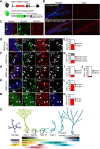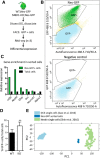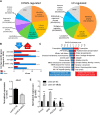Methyl-CpG-Binding Protein MBD1 Regulates Neuronal Lineage Commitment through Maintaining Adult Neural Stem Cell Identity
- PMID: 28100736
- PMCID: PMC5242405
- DOI: 10.1523/JNEUROSCI.1075-16.2016
Methyl-CpG-Binding Protein MBD1 Regulates Neuronal Lineage Commitment through Maintaining Adult Neural Stem Cell Identity
Abstract
Methyl-CpG-binding domain 1 (MBD1) belongs to a family of methyl-CpG-binding proteins that are epigenetic "readers" linking DNA methylation to transcriptional regulation. MBD1 is expressed in neural stem cells residing in the dentate gyrus of the adult hippocampus (aNSCs) and MBD1 deficiency leads to reduced neuronal differentiation, impaired neurogenesis, learning deficits, and autism-like behaviors in mice; however, the precise function of MBD1 in aNSCs remains unexplored. Here, we show that MBD1 is important for maintaining the integrity and stemness of NSCs, which is critical for their ability to generate neurons. MBD1 deficiency leads to the accumulation of undifferentiated NSCs and impaired transition into the neuronal lineage. Transcriptome analysis of neural stem and progenitor cells isolated directly from the dentate gyrus of MBD1 mutant (KO) and WT mice showed that gene sets related to cell differentiation, particularly astrocyte lineage genes, were upregulated in KO cells. We further demonstrated that, in NSCs, MBD1 binds and represses directly specific genes associated with differentiation. Our results suggest that MBD1 maintains the multipotency of NSCs by restraining the onset of differentiation genes and that untimely expression of these genes in MBD1-deficient stem cells may interfere with normal cell lineage commitment and cause the accumulation of undifferentiated cells. Our data reveal a novel role for MBD1 in stem cell maintenance and provide insight into how epigenetic regulation contributes to adult neurogenesis and the potential impact of its dysregulation.
Significance statement: Adult neural stem cells (aNSCs) in the hippocampus self-renew and generate neurons throughout life. We show that methyl-CpG-binding domain 1 (MBD1), a DNA methylation "reader," is important for maintaining the integrity of NSCs, which is critical for their neurogenic potency. Our data reveal a novel role for MBD1 in stem cell maintenance and provide insight into how epigenetic regulation preserves the multipotency of stem cells for subsequent differentiation.
Keywords: FACS-seq; MBD1; epigenetics; lineage restriction; neural stem cells; neurogenesis.
Copyright © 2017 the authors 0270-6474/17/370523-14$15.00/0.
Figures







Similar articles
-
Epigenetic regulation of the stem cell mitogen Fgf-2 by Mbd1 in adult neural stem/progenitor cells.J Biol Chem. 2008 Oct 10;283(41):27644-27652. doi: 10.1074/jbc.M804899200. Epub 2008 Aug 8. J Biol Chem. 2008. PMID: 18689796 Free PMC article.
-
Mice lacking methyl-CpG binding protein 1 have deficits in adult neurogenesis and hippocampal function.Proc Natl Acad Sci U S A. 2003 May 27;100(11):6777-82. doi: 10.1073/pnas.1131928100. Epub 2003 May 14. Proc Natl Acad Sci U S A. 2003. PMID: 12748381 Free PMC article.
-
Epigenetic regulation of miR-184 by MBD1 governs neural stem cell proliferation and differentiation.Cell Stem Cell. 2010 May 7;6(5):433-44. doi: 10.1016/j.stem.2010.02.017. Cell Stem Cell. 2010. PMID: 20452318 Free PMC article.
-
Regulation of Adult Mammalian Neural Stem Cells and Neurogenesis by Cell Extrinsic and Intrinsic Factors.Cells. 2021 May 10;10(5):1145. doi: 10.3390/cells10051145. Cells. 2021. PMID: 34068607 Free PMC article. Review.
-
Adult neural stem cells stake their ground.Trends Neurosci. 2014 Oct;37(10):563-71. doi: 10.1016/j.tins.2014.08.006. Epub 2014 Sep 12. Trends Neurosci. 2014. PMID: 25223700 Free PMC article. Review.
Cited by
-
Proteins That Read DNA Methylation.Adv Exp Med Biol. 2022;1389:269-293. doi: 10.1007/978-3-031-11454-0_11. Adv Exp Med Biol. 2022. PMID: 36350514
-
RGS6 Mediates Effects of Voluntary Running on Adult Hippocampal Neurogenesis.Cell Rep. 2020 Aug 4;32(5):107997. doi: 10.1016/j.celrep.2020.107997. Cell Rep. 2020. PMID: 32755589 Free PMC article.
-
Brain injury and neural stem cells.Neural Regen Res. 2018 Jan;13(1):7-18. doi: 10.4103/1673-5374.224361. Neural Regen Res. 2018. PMID: 29451199 Free PMC article. Review.
-
Adult Neural Stem Cell Multipotency and Differentiation Are Directed by the Methyl-CpG-Binding Protein MBD1.J Neurosci. 2017 Apr 19;37(16):4228-4230. doi: 10.1523/JNEUROSCI.0411-17.2017. J Neurosci. 2017. PMID: 28424299 Free PMC article. No abstract available.
-
Maternal Diabetes Deregulates the Expression of Mecp2 via miR-26b-5p in Mouse Embryonic Neural Stem Cells.Cells. 2023 May 30;12(11):1516. doi: 10.3390/cells12111516. Cells. 2023. PMID: 37296636 Free PMC article.
References
-
- Amador-Arjona A, Cimadamore F, Huang CT, Wright R, Lewis S, Gage FH, Terskikh AV. SOX2 primes the epigenetic landscape in neural precursors enabling proper gene activation during hippocampal neurogenesis. Proc Natl Acad Sci U S A. 2015;112:E1936–E1945. doi: 10.1073/pnas.1421480112. - DOI - PMC - PubMed
-
- Beckervordersandforth R, Tripathi P, Ninkovic J, Bayam E, Lepier A, Stempfhuber B, Kirchhoff F, Hirrlinger J, Haslinger A, Lie DC, Beckers J, Yoder B, Irmler M, Götz M. In vivo fate mapping and expression analysis reveals molecular hallmarks of prospectively isolated adult neural stem cells. Cell Stem Cell. 2010;7:744–758. doi: 10.1016/j.stem.2010.11.017. - DOI - PubMed
Publication types
MeSH terms
Substances
Grants and funding
LinkOut - more resources
Full Text Sources
Other Literature Sources
Molecular Biology Databases
Research Materials
